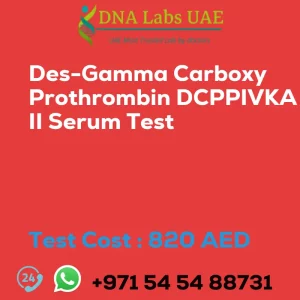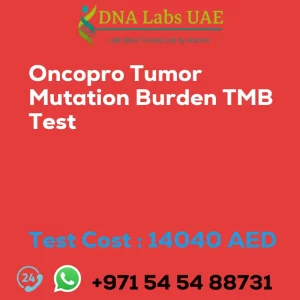IMMUNOHISTOCHEMISTRY PD-L1 SP263 VENTANA Test
Cost: AED 790.0
Are you looking for information about the IMMUNOHISTOCHEMISTRY PD-L1 SP263 VENTANA Test? Look no further! DNA Labs UAE offers this test at a cost of AED 790.0. Read on to learn more about the test, its components, and how it can help in diagnosing cancer.
Test Name: IMMUNOHISTOCHEMISTRY PD-L1 SP263 VENTANA Test
Components: The test costs AED 790.0 and requires a tumor tissue sample submitted in 10% Formal-saline or a Formalin fixed paraffin embedded block. The sample should be shipped at room temperature. Additionally, a copy of the Histopathology report, the site of biopsy, and the patient’s clinical history should be provided.
Report Delivery:
Sample: Daily by 6 pm
Report Block: 5 days
Tissue Biopsy: 5 days
Tissue large complex: 7 days
Method:
Immunohistochemistry
Test Type:
Cancer
Doctor:
Oncologist, Pathologist
Test Department:
HISTOLOGY
Pre Test Information:
A copy of the Histopathology report, the site of biopsy, and the patient’s clinical history should be provided.
Test Details:
The PD-L1 SP263 test is an immunohistochemistry (IHC) test used to evaluate the expression of the PD-L1 protein in tumor tissue samples. It is performed using the Ventana PD-L1 SP263 assay, which is a specific antibody designed to detect PD-L1.
PD-L1 is a protein that is expressed on the surface of tumor cells and some immune cells. It plays a crucial role in regulating the immune response by interacting with its receptor PD-1 on T cells. When PD-L1 binds to PD-1, it inhibits the activity of T cells, allowing the tumor to evade immune attack.
The PD-L1 SP263 test is commonly used in cancer research and clinical practice, particularly in the field of immuno-oncology. It helps determine the level of PD-L1 expression in tumor cells, which can guide treatment decisions for patients with certain types of cancer.
The test involves staining tumor tissue sections with the PD-L1 SP263 antibody, followed by visualization using an automated staining system. The staining intensity and percentage of PD-L1 positive tumor cells are evaluated by a pathologist, who assigns a score based on predefined criteria. This score can then be used to classify tumors as PD-L1 positive or negative.
The PD-L1 SP263 test is used as a predictive biomarker for response to immune checkpoint inhibitors, such as PD-1 or PD-L1 inhibitors. Tumors with high levels of PD-L1 expression are more likely to respond to these therapies, as blocking the PD-1/PD-L1 interaction can enhance the anti-tumor immune response.
It is important to note that the PD-L1 SP263 test is just one of several available assays for PD-L1 testing, and different assays may have different scoring systems and cutoffs for determining PD-L1 positivity. Therefore, the results of the PD-L1 SP263 test should be interpreted in conjunction with other clinical and pathological factors.
| Test Name | IMMUNOHISTOCHEMISTRY PD-L1 SP263 VENTANA Test |
|---|---|
| Components | |
| Price | 790.0 AED |
| Sample Condition | Submit tumor tissue in 10% Formal-saline OR Formalin fixed paraffin embedded block. Ship at room temperature. Provide a copy of the Histopathology report, Site of biopsy and Clinical history. |
| Report Delivery | Sample Daily by 6 pm; Report Block: 5 days Tissue Biopsy: 5 days Tissue large complex : 7 days |
| Method | Immunohistochemistry |
| Test type | Cancer |
| Doctor | Oncologist, Pathologist |
| Test Department: | HISTOLOGY |
| Pre Test Information | Provide a copy of the Histopathology report, Site of biopsy and Clinical history. |
| Test Details |
The PD-L1 SP263 test is an immunohistochemistry (IHC) test used to evaluate the expression of the PD-L1 protein in tumor tissue samples. It is performed using the Ventana PD-L1 SP263 assay, which is a specific antibody designed to detect PD-L1. PD-L1 is a protein that is expressed on the surface of tumor cells and some immune cells. It plays a crucial role in regulating the immune response by interacting with its receptor PD-1 on T cells. When PD-L1 binds to PD-1, it inhibits the activity of T cells, allowing the tumor to evade immune attack. The PD-L1 SP263 test is commonly used in cancer research and clinical practice, particularly in the field of immuno-oncology. It helps determine the level of PD-L1 expression in tumor cells, which can guide treatment decisions for patients with certain types of cancer. The test involves staining tumor tissue sections with the PD-L1 SP263 antibody, followed by visualization using an automated staining system. The staining intensity and percentage of PD-L1 positive tumor cells are evaluated by a pathologist, who assigns a score based on predefined criteria. This score can then be used to classify tumors as PD-L1 positive or negative. The PD-L1 SP263 test is used as a predictive biomarker for response to immune checkpoint inhibitors, such as PD-1 or PD-L1 inhibitors. Tumors with high levels of PD-L1 expression are more likely to respond to these therapies, as blocking the PD-1/PD-L1 interaction can enhance the anti-tumor immune response. It is important to note that the PD-L1 SP263 test is just one of several available assays for PD-L1 testing, and different assays may have different scoring systems and cutoffs for determining PD-L1 positivity. Therefore, the results of the PD-L1 SP263 test should be interpreted in conjunction with other clinical and pathological factors. |







